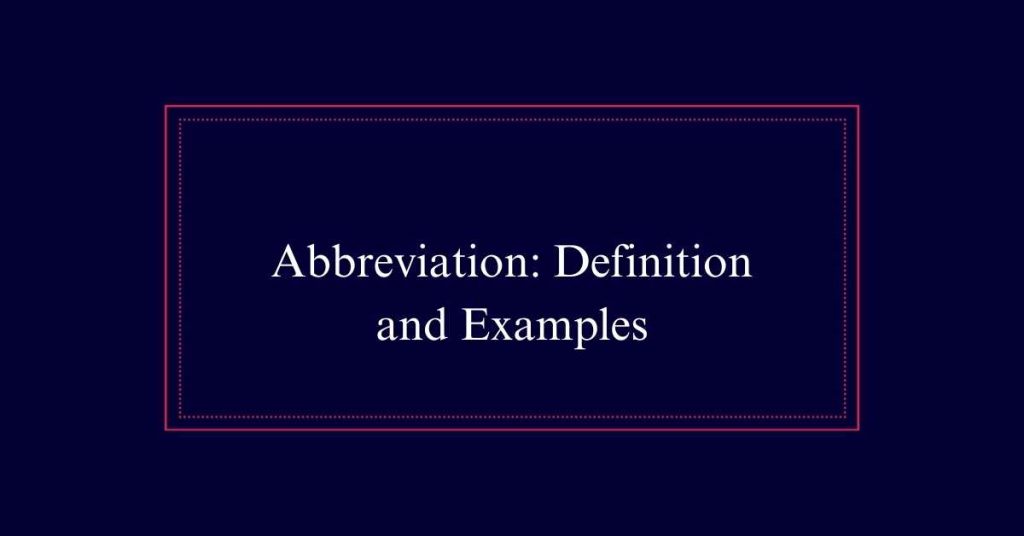Abbreviation: Definition and Examples
An abbreviation is a shortened form of a word or phrase used to simplify communication. Common types include acronyms, like NASA, pronounced as a word, and initialisms, like FBI, pronounced as individual letters. Contractions omit letters and use apostrophes, while shortenings and clippings reduce words without altering their meaning.
Abbreviations are prevalent in technical, academic, and professional writing, enhancing readability and preventing confusion. Examples also include courtesy titles, such as Mr. and Dr., and academic degrees, like B.A. and Ph.D.
Acronyms Vs. Initialisms
Acronyms and initialisms are both formed by combining the initial letters of words. Acronyms are pronounced as single words. For example, NASA (National Aeronautics and Space Administration) is an acronym.
Initialisms, on the other hand, are pronounced as a series of letters. An example is FBI (Federal Bureau of Investigation).
Both acronyms and initialisms are written in all capital letters. They help simplify lengthy phrases and improve communication efficiency. However, it is important to use the initial sound of the word for indefinite articles before acronyms. For instance, one would say ‘an FBI agent’ but ‘a NASA mission.’
Pronunciation of Acronyms
When pronouncing acronyms, it is important to articulate them as single words rather than individual letters. This practice helps maintain clarity and consistency in communication.
Acronyms like NASA, which stands for National Aeronautics and Space Administration, are spoken as ‘na-sa’ and not as ‘N-A-S-A.’ Similarly, UNESCO, the United Nations Educational, Scientific and Cultural Organization, is pronounced as ‘you-NES-co.’
Proper pronunciation aids in understanding and avoids confusion. It is crucial to familiarize oneself with the correct pronunciation of commonly used acronyms to guarantee effective communication. This approach also distinguishes acronyms from initialisms, which are pronounced differently, as separate letters rather than single words.
Pronunciation of Initialisms
Initialisms are pronounced as a series of individual letters rather than as single words. This distinguishes them from acronyms, which are spoken as whole words. Each letter in an initialism is articulated separately, making them easy to recognize and understand.
Examples of initialisms include:
- FBI (Federal Bureau of Investigation)
- NASA (National Aeronautics and Space Administration)
- ATM (Automated Teller Machine)
- BBC (British Broadcasting Corporation)
- USB (Universal Serial Bus)
When using initialisms, clarity is key. Pronouncing each letter distinctly helps prevent confusion. For instance, saying ‘F-B-I’ ensures the listener understands the reference to the investigative agency, rather than mishearing it as a single, unfamiliar word.

Courtesy Title Abbreviations
Courtesy title abbreviations are commonly used in both formal and informal communication. These titles help convey respect and identify the social or professional status of individuals.
Common abbreviations include:
- Mr. for Mister
- Mrs. for Mistress
- Miss for an unmarried woman
- Ms. for a woman regardless of marital status
Additionally, Dr. is used for Doctor, and Prof. for Professor. In American English, these abbreviations are followed by a period, while British English generally omits the period.
Academic Degree Abbreviations
In addition to courtesy titles, academic degree abbreviations are widely used to denote educational qualifications. They provide a concise way to communicate one’s level of education and area of expertise.
Commonly, these abbreviations follow the name of the individual.
- B.A.: Bachelor of Arts
- B.S.: Bachelor of Science
- M.A.: Master of Arts
- M.S.: Master of Science
- Ph.D.: Doctor of Philosophy
American Vs. British Titles
American and British English differ in how they abbreviate courtesy titles. In American English, titles like Mr., Mrs., and Dr. are followed by a period. For example, ‘Mr. John Smith’ or ‘Dr. Jane Doe.’ This style is consistent across most American writing.
In contrast, British English omits the period after these abbreviations. Titles become Mr, Mrs, and Dr without the trailing period. For example, ‘Mr John Smith’ or ‘Dr Jane Doe.’ This difference in punctuation may seem minor but is a notable distinction in written communication.
Common Latin Abbreviations
Latin abbreviations, such as e.g., i.e., and etc., are frequently used in academic and professional writing. They help to convey complex ideas succinctly. Understanding these abbreviations is crucial for clear communication.
Here are five common Latin abbreviations:
- e.g.: Exempli gratia, meaning ‘for example’
- i.e.: Id est, meaning ‘that is’
- etc.: Et cetera, meaning ‘and so forth’
- vs.: Versus, meaning ‘against’
- et al.: Et alii, meaning ‘and others’
Abbreviation Variations
Abbreviation variations can differ greatly based on style guides and regional practices. American English often uses periods in abbreviations, like ‘Dr.’ for Doctor. British English may omit these periods, using ‘Dr’ instead. Academic degrees also follow this pattern. For instance, ‘Ph.D.’ in American English might appear as ‘PhD’ in British English.
Another factor is the specific style guide in use. The Associated Press (AP) Stylebook might suggest different abbreviations than the Modern Language Association (MLA) Handbook. Some abbreviations, like ‘U.S.’ for United States, may appear with or without periods depending on the context.
Time and Date Abbreviations
In addition to regional variations in abbreviations, time and date abbreviations are also important to comprehend. These abbreviations help convey temporal information efficiently.
Common examples include:
- a.m.: Stands for ‘ante meridiem,’ which means before noon.
- p.m.: Stands for ‘post meridiem,’ which means after noon.
- Mon.: Short for Monday, often used in schedules.
- Jan.: Abbreviation for January, typically seen in calendars.
- 2023: Often shortened to ’23 in informal contexts.
Place Abbreviations
Place abbreviations are commonly used to guarantee countries and regions efficiently. These abbreviations simplify communication and save space.
For example, ‘U.S.’ stands for the United States, ‘U.K.’ represents the United Kingdom, and ‘E.U.’ refers to the European Union. Another example is ‘U.A.E.,’ which stands for the United Arab Emirates.
These abbreviations are widely recognized and used in global discourse, including media, business, and academia. They help streamline text and are particularly useful in headlines and documents where brevity is necessary.
Additionally, such abbreviations follow standard conventions, making them easy to understand across different contexts. This standardized usage assures clarity and uniformity in written and spoken communication.







